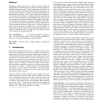Free Online Productivity Tools
i2Speak
i2Symbol
i2OCR
iTex2Img
iWeb2Print
iWeb2Shot
i2Type
iPdf2Split
iPdf2Merge
i2Bopomofo
i2Arabic
i2Style
i2Image
i2PDF
iLatex2Rtf
Sci2ools
SMA
2010
ACM
2010
ACM
Efficient simplex computation for fixture layout design
Designing a fixture layout of an object can be reduced to computing the largest simplex and the resulting simplex is classified using the radius of the largest inscribed ball centered at the origin. We present three different algorithms to compute such a simplex: a simple randomized algorithm, an interchange algorithm, and a branch-and-bound algorithm. We also present methods to combine different algorithms to improve the performance and highlight their performance on complex 3D models consisting of thousands of triangles. Our randomized algorithm computes a feasible fixture layout in linear time and is well-suited for realtime applications. The interchange algorithm computes an optimal simplex in linear time such that no single vertex can be changed to enlarge the simplex. The branch-and-bound algorithm computes the largest simplex by using lower and upper bounds on the radius of the inscribed ball. CR Categories: J.6 [Computer-Aided Engineering]: Computer-aided design; I.2.9 [Artifi...
Related Content
| Added | 06 Dec 2010 |
| Updated | 06 Dec 2010 |
| Type | Conference |
| Year | 2010 |
| Where | SMA |
| Authors | Yu Zheng, Ming C. Lin, Dinesh Manocha |
Comments (0)

